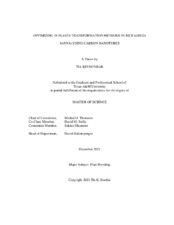| dc.description.abstract | CRISPR/Cas-based gene editing technologies offer the potential to precisely modify crops; however, in vitro plant transformation and regeneration techniques present a bottleneck due to the lengthy and genotype-specific tissue culture process. Ideally, in planta transformation can bypass tissue culture and directly lead to transformed plants, but efficient in planta delivery and transformation remains a challenge. Our research investigates transformation methods that have the potential to directly alter germline cells, eliminating the challenge of in vitro plant regeneration. Recent studies have demonstrated that carbon nanotubes (CNTs) loaded with plasmid DNA can diffuse through plant cell walls, facilitating transient expression of foreign genetic elements in plant tissues. Therefore, CNTs delivering CRISPR/Cas expressing vectors into mature embryos should be able to create heritable genetic edits. To test this hypothesis, CNT delivery into rice tissues was initially tested using leaf infiltration with reporter genes. After showing successful passive delivery of plasmid-carrying CNTs expressing reporter genes into leaves, rice seeds and excised mature embryos were then tested for CNT-based delivery of CRISPR/Cas reagents. The phytoene desaturase gene was targeted for knockout as homozygous or biallelic knockouts result in albino phenotypes. Rice seeds and excised embryos were imbibed in CRISPR plasmid-CNT solutions, and successful delivery and gene editing was observed visually and by sequencing. Data indicate that CNTs transporting CRISPR vectors are capable of passive diffusion and transient expression in rice tissues. Moreover, a similar approach was initiated in cotton pollen tubes, but more work is needed to keep the pollen tubes from rupturing in the CNT solution. Overall, the results show that CNT-based delivery shows promise for in planta transformation and further optimization of our gene editing protocol has the potential to accelerate crop improvement to meet the challenges of future global crop production. | |


